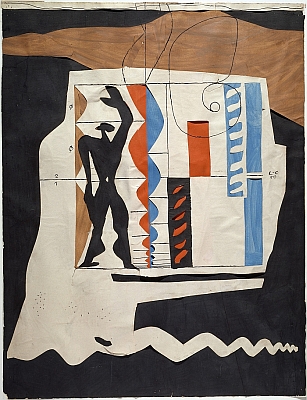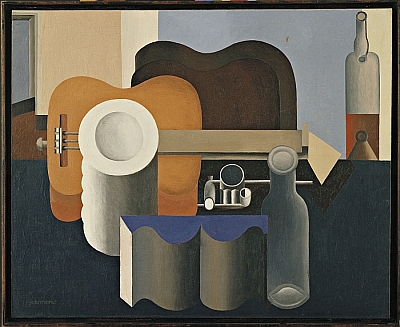On days when his sketches didn't meet with his own, self-critical, approval, the Swiss architect and urban planner Le Corbusier is reported to have laid down his pencil and quietly reflected, "c'est difficile, l'architecture"
Equally difficile is describing and explaining the multifarious talents and passions of Le Corbusier.
One option, arguably the best option, is to focus on just one aspect of Le Corbusier's oeuvre and to use this concentrated analysis as a conduit through which to introduce the broader picture; and just such an approach has been undertaken by the Centre Pompidou for their exhibition "Le Corbusier - The measures of man"

Born in 1887 as Charles-Édouard Jeanneret-Gris in La Chaux-de-Fonds in Switzerland's Jura mountains, the future Le Corbusier initially began training for a career as a clockmaker, before in the course of his studies at the local arts and crafts college his attention increasingly turned to art and for all architecture. A passionate traveller Charles-Édouard's formative years were dominated by trips throughout Switzerland, the Balkans, Greece, Turkey, France and Italy; trips during which he completed innumerate studies of the architecture and landscapes he encountered, and for all the many examples of classical Roman and Greek architecture he encountered. Experiences which greatly strengthened his passion for architecture.
In 1910 Charles-Édouard's travels brought him to Dresden, specifically the Hellerau arts and crafts community in Dresden where his brother Albert was studying music under the Swiss composer Émile Jaques-Dalcroze. Fascinated by Dalcroze's eurhythmics teaching method with its combination of music, movement and the idea of sensing the music rather than simply hearing it, the young Charles-Édouard was motivated to learn more about not only Dalcroze's philosophies but similar reformist, psychophysical theories and practices. The combination of his interest in and understanding of classical architecture and his new-found passion for the spirit of progressive thinking so indicitive of the age slowly led Charles-Édouard to begin a series of studies on the proportions of the human body and thus a search for a unifying, human-based, system of measurement; studies which in many ways would define and guide his future work and studies which form the curatorial basis of "Le Corbusier - The measures of man"
Divided into twelve sections "The measures of man" takes the visitor on a tour through Charles-Édouard Jeanneret-Gris' life and works from his early travels and the contemporary literature of the early 20th century which helped shape his world view, over his early purist, cubist, works and onto his conversion to the nom de plume, or perhaps better put, his nom de guerre, "Le Corbusier" and his (in)famous l'Esprit Nouveau pavilion at the 1925 World's Fair in Paris, before in the middle of the exhibition one reaches the fulmination of the experimentation and research of the previous three decades: Modulor.
Much like Da Vinci's Vitruvian Man and the numerous variations thereon, Modulor explores the proportions of a "standardised", "ideal" human: Da Vinci's Vitruvian Man standing 24 palms tall, Le Corbusier's Modulor Man 1.83 metres tall, 2.26 with his arm raised above his head. In the course of some 20 sketches "The measures of man" neatly visualises how Le Corbusier developed, and redeveloped, his theory, before in the following rooms the curators explain how Le Corbusier subsequently utilised his Modulor system: the numerous Unité d'habitation tower block complexes in France and Germany, the Carpenter Center for the Visual Arts in Cambridge, Massachusetts, the chapel of Notre Dame du Haut in Ronchamp, France, the town of Chandigarh in northern India and ultimately his own 14 sqm Le Cabanon house in Roquebrune-Cap-Martin on France's Côte d'Azur - where the exhibition ends and we thus leave Le Corbusier to enjoy his hard earned peace and quiet.
In addition to exploring Le Corbusier's anthropomorphic studies,"The measures of man" also explains Le Corbusier's "five principles of architecture", principles perhaps best exemplified by his Villa Savoye project, and includes an overview of "Le Corbusier's" furniture design - something that we believe must by law be included in all Le Corbusier exhibitions, regardless of how well or otherwise it fits the subject at hand. And in the case of the Centre Pompidou exhibition it doesn't fit particularly well. Largely because, as we all more or less understand yet stubbornly refuse to properly accept, the furniture is much more Charlotte Perriand's work, and so doesn't really help us understand how Le Corbusier understood the human body. That said there is a fascinating early example of the LC2 armchair on display, but that is a subject for another post..
An excellently conceived and realised exhibition which makes an occasionally très difficile subject both accessible and entertaining, "The measures of man" provides a very nice overview of why Le Corbusier is such a fascinating and important figure and does so with both a depth that ensures those familiar with Le Corbusier can find new insights and new perspectives, and an uncluttered lightness of touch for all who may be familiar with the name, but not the relevance and full breadth of the canon.
Le Corbusier - The Measures of Man runs at Le Centre Pompidou, Place Georges-Pompidou, 75191 Paris until Monday August 3rd. Full details can be found at www.centrepompidou.fr
